Abstract
The world of business has always been an environment known for rapid, frequent, and sometimes unpredictable change. In order to stay in competition and preserve the advantage, the businesses are to remain flexible and responsive to the changing environment and situation in the market. This presentation explores the case study of Honda throughout several decades since the 1940s. The main subject discussed is change management, the need for change, and how Honda could adjust its strategy to become a stronger competitor in the market.
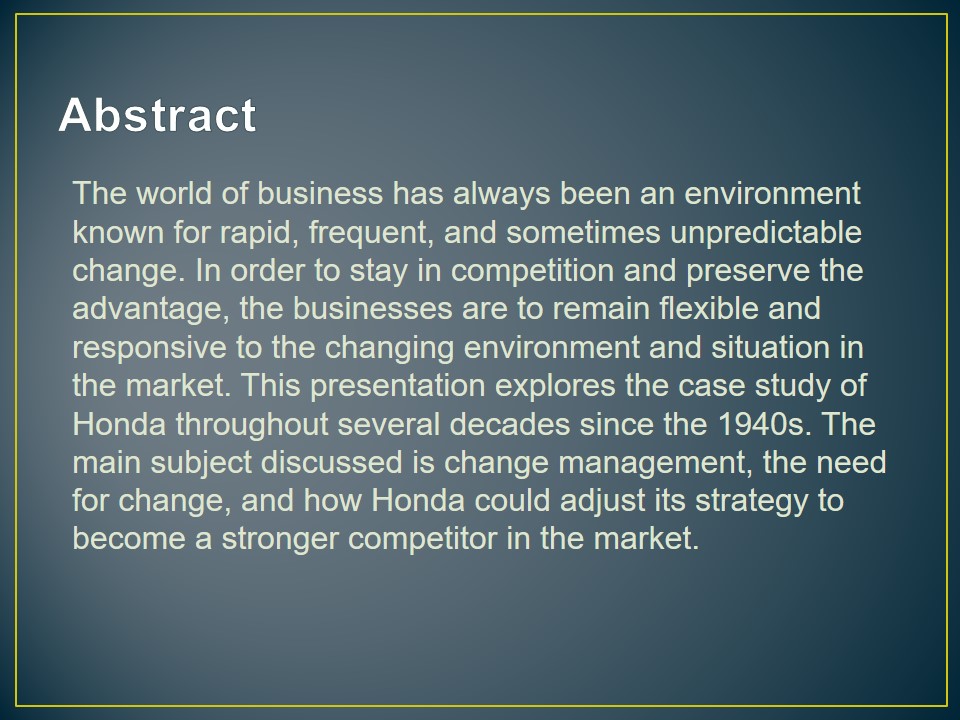
Introduction
This presentation includes:
- A summary of the Case Study about the development of Honda and its successful expansion in the USA market.
- The drivers of this marketing success in terms of change management and flexibility.
- The performance of Honda compared to its primary competitors of the time (Yamaha, Kawasaki, Suzuki).
- The discussion of concepts of change and change management and the need for constant change in business.
- The other concepts such as resistance to change, sustaining change, and change paradigm in relation to the Honda Case Study.

Case Summary
- Honda Motor Company (founded by Soichiro Honda in Japan before the World War II).
- Devastation after the War resulted in the forced downsizing of the company.
- Honda manufactured motorcycles that were in demand in Japan due to their convenience and easy maintenance.
- Honda Technical Research Institute – focused on engine improvement.
- First A-type, 2 stroke engine presented in 1947.
- In the 40s Honda faced mainly weak competitor with cheap equipment, unreliable materials, and limited capacities.
- Honda expanded at the beginning of the 50s. Objectives:
- create a multiproduct line;
- become leaders in innovation;
- search for marketing opportunities for mass production.
- End of the 50s – huge success, a new popular model (50cc Honda).
- Result: Investment in the future production plan and decision to penetrate the US market.
- Honda became the world’s largest motorcycle manufacturer ($55 million revenue).
- Honda’s light-weight models gained more success then local ones. The company gradually expanded throughout the US. Costs: regional advertising.
- Main competitors: Yamaha, Kawasaki, Suzuki.
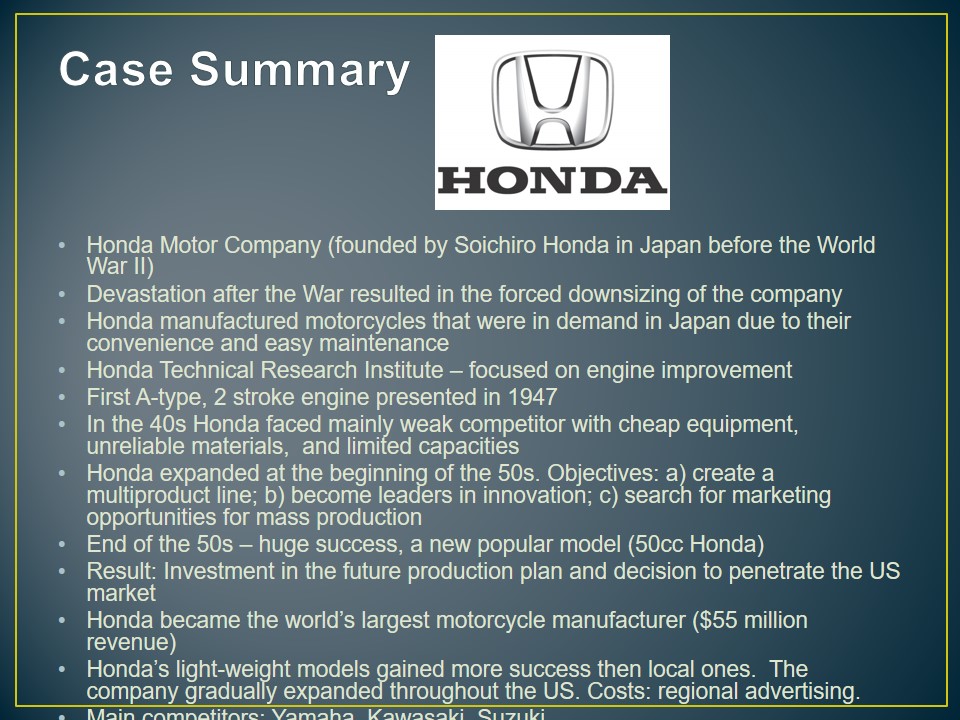
Analysis of Honda’s Approach
- Honda’s advantage and fact growth in the American market is viewed as stimulated by their “marketing philosophy” based on market share and sales volume as key contributors to success.
- Focus on long-term benefits, but not short-term gains.
- The sales plan is built based on the market share and potential growth opportunities.
- Goal: increase the company’s sales volume faster than the competitors do.
- Product changes are defined by market threats and opportunities.
- Prices are adjusted to gain larger market share.
- Effective and focused marketing wherever there is serious competition.
- Short-term costs are outweighed by long-term advantages.
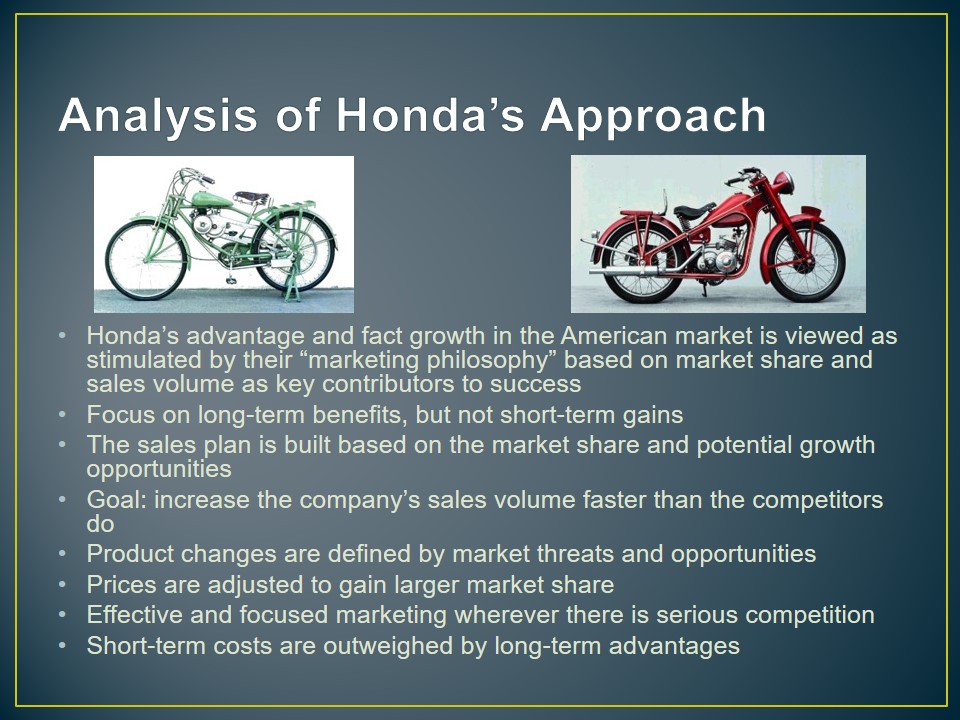
Performance of Honda and its Competitors
The performance of Honda in every aspect (including investment and expenditures) is more active than that of Yamaha, Kawasaki, and Suzuki.
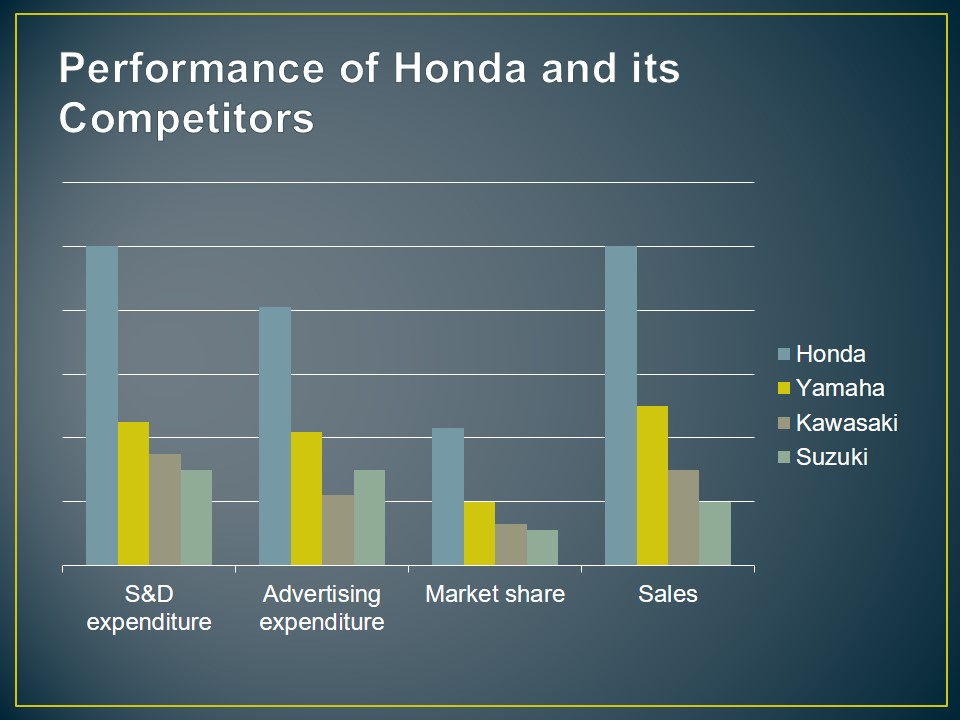
Analysis and Commentary
As seen from the chart:
- Honda outperformed all of its competitors in each sector.
- All of the Japanese motorcycle manufacturing companies adhered to the same strategy.
- However, Honda has demonstrated more aggressive advertising campaigns seeking for larger market share.
- Honda’s investment in the production and advertisement are larger than those of the competitors.
- Conclusion: Honda was better at planning and implementing change, more flexible, and responsive to the shifting market environment.
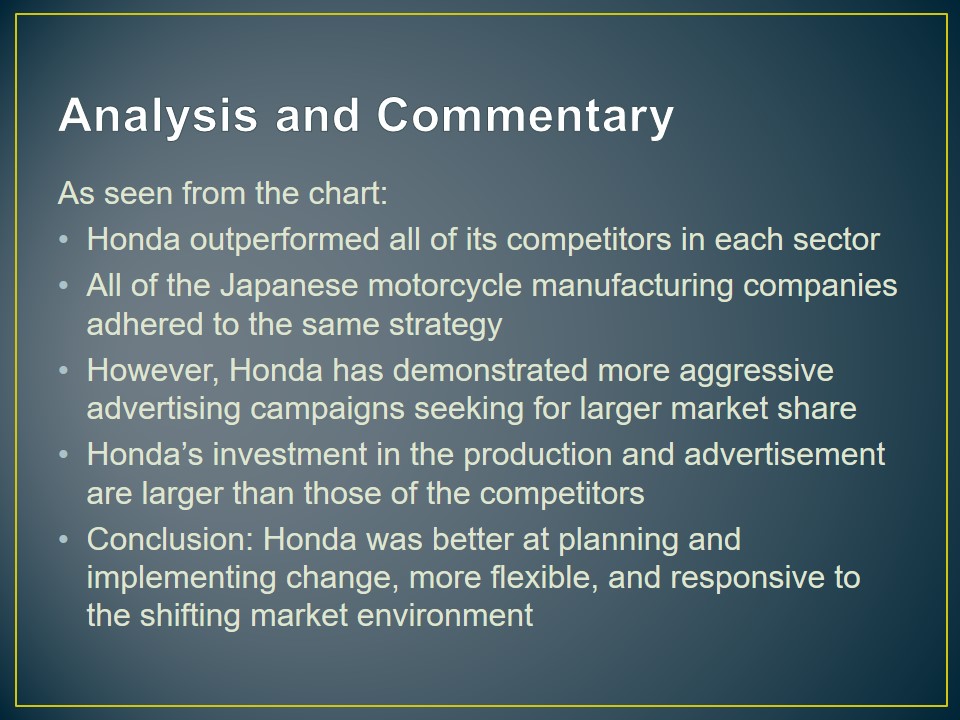
Why change management is highly essential
- Business is one of the fastest developing spheres of knowledge where new concepts, strategies, experiences, and techniques appear every day.
- As a result, to remain successful in the world of business one is to learn and self-improve on the ongoing basis.
- This tendency involves both people and companies.
- A company’s presence in the market is characterized with constant change of environments (economic conditions, customers’ preferences, competition).
- In response to the change of the environment, a business is to adjust employing its own change strategies in order to survive.
- Honda went through major change developing new models of motorcycles and then expanding to a foreign market with new environment, demand, and conditions.
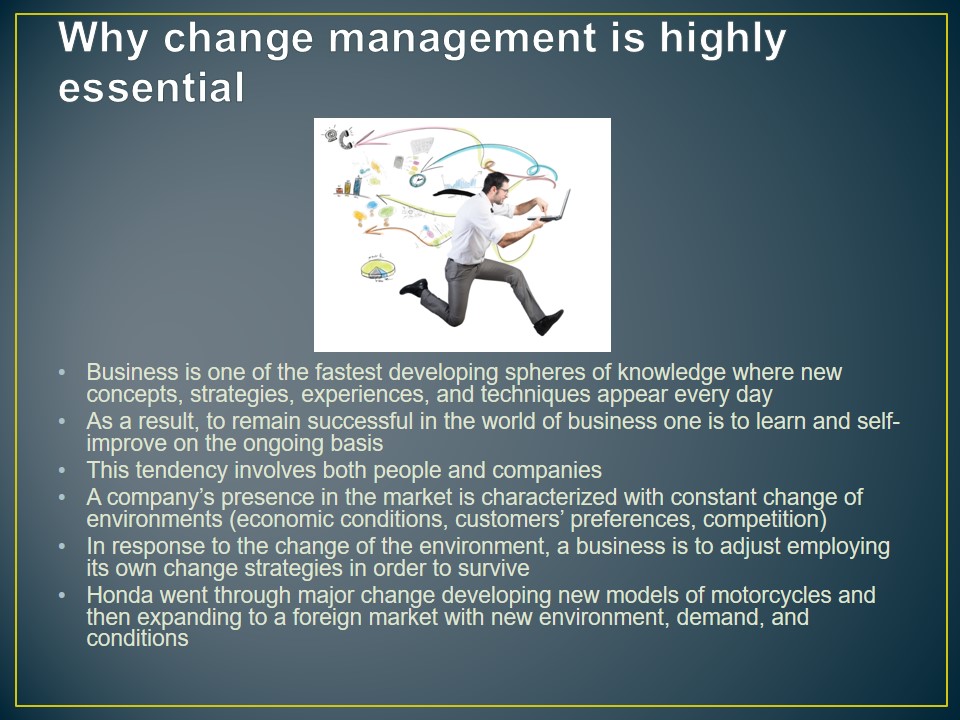
How change integrated with management development?
- Change has two primary aspects – technical and people (Prosci, 2016).
- Readiness for change is required in both aspects – a company is to have enough capacities and resources to accomplish the change technically, and the staff it to be ready to embrace the new policies, practices, duties, and goals (Prosci, 2016).
- The main spheres where Honda had implemented change were sales, manufacturing, market research, communication, investment, advertising – in other words, basically, the change occurred at every dimension of the business.
- For Honda, change was connected to serious risk as the company had to make a massive investment and produce the motorbikes for the new market which could have been reluctant to purchase them.
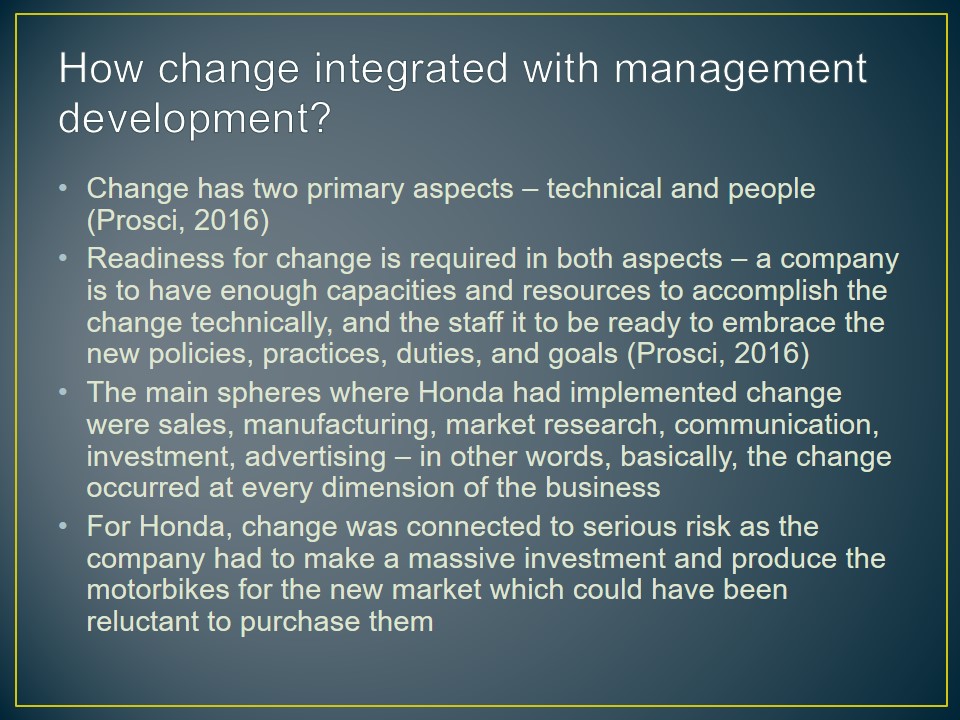
How did Honda start to change?
- The change at Honda began even before the company started to expand to a foreign market.
- Honda improved its performance in the domestic market prior to expansion.
- In Japan, devastated by war, the competition was weak.
- The clever market research allowed Honda to identify the need of the consumers for light-weight motorcycles of higher quality and with more efficient engines.
- Having produced a model favored by the buyers, Honda managed to increase its revenue.
- In turn, as the demand grew, Honda supplied more motorcycles increasing the rate of production. As a result, the sale revenues went up very fast.

What did Honda change?
- As the financial resources of the business increased – Honda obtained versatile opportunities: the business could have started to produce new models or switch to luxury category.
- However, the economy of Japan did not promise many customers for expensive motorcycles.
- Japan decided to turn to a country with a large population whose economy remained strong.
- The risky change involved adjustments at each level – the packaging, shipping, distribution, research of the new market and culture, developing appropriate advertisements and prices, Learning about the threats and opportunities.
- Honda made a huge investment and prepared for this bold change.
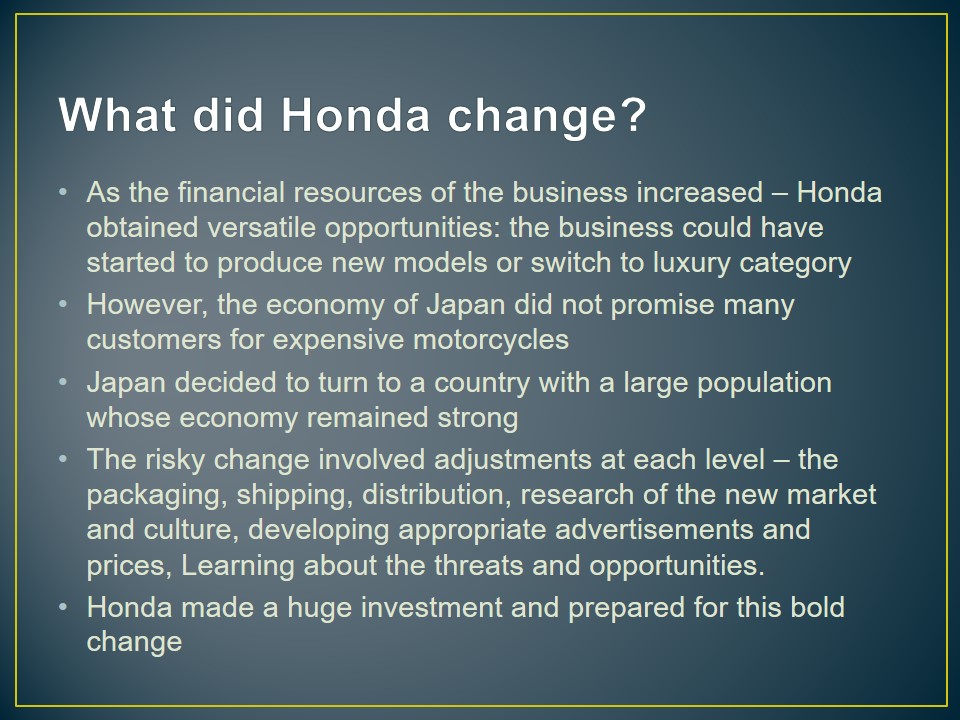
Why to change?
- Compared to the success of the three main Japanese competitors marketing similar products, Honda had the biggest success in the US.
- This tendency can be explained by the company’s deep understanding of the areas of change and the reasons why it had to be implemented.
The aspects that encouraged change for Honda:
- The presence of strong competition and similar products.
- The need to sell more motorcycles compared to the competitors.
- The need to appeal to the Western market and the consumers with a cultural background different from the Japanese.

Resistance to change
Change may happen gradually and at one dimension at a time (evolutionary), or rapidly and everywhere at once (revolutionary) (Jones, 2012). The latter kind of change is likely to face more resistance (Jones, 2012).
Honda’s change was revolutionary and required readiness among people and technical abilities of the company.
- People changes:
- demand for more productivity;
- change in salaries and benefits;
- training of staff to orientate them at work with the new market;
- hiring and selection caused by expansion.
- Possible resistance areas:
- clash of cultures;
- lack of desire to work more;
- reluctance to learn new skills.
- Technical changes:
- larger financial resources;
- need for more materials;
- supply chain change;
- logistics of transportation (shipping and packaging).
- Possible resistance areas:
- failure to gain enough revenues to continue investing;
- inability to find affordable materials in sufficient quantities;
- difficulties sending the products to the new market.
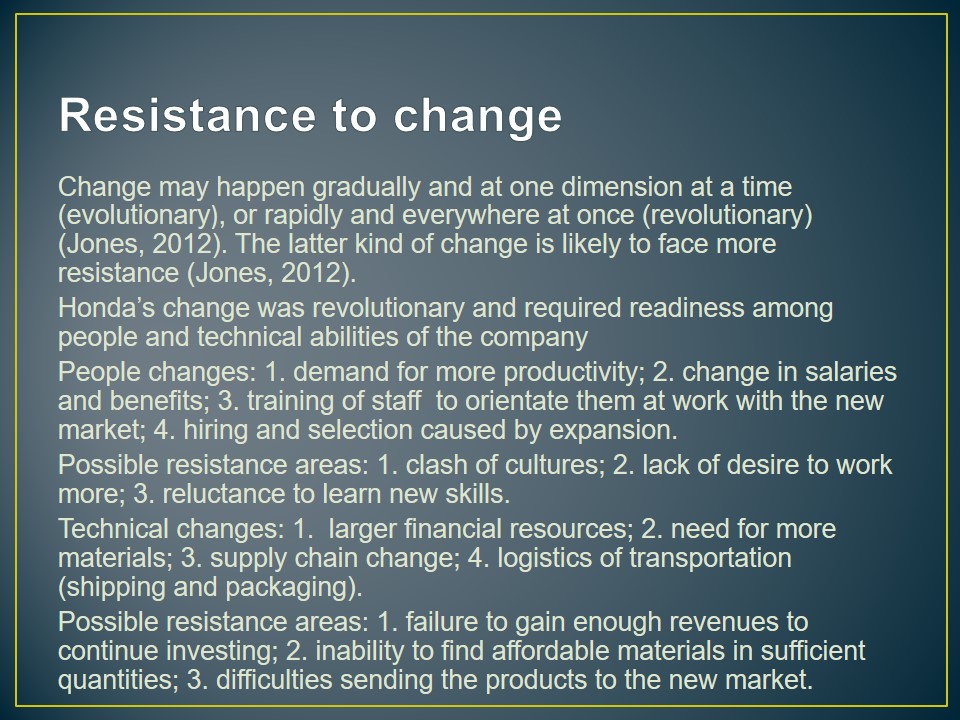
Change agents
- Initially, the strategy chosen by Honda for expansion was successful.
- The main drivers of change were the increased productivity and aggressive advertising.
- Honda’s advertising expenditures exceeded those of its competitors (8.1 million dollars spent by Honda versus 4.2, 2.2, and 3 million dollars spent by Yamaha, Kawasaki, and Suzuki respectively).
- Finally, Honda’s expansion within the USA was driven by the market share variables primarily as the main determinant of the future growth potential and sales revenue.

Sustaining change
- Having won the competitive advantage in certain regions, Honda was focused on its maintenance.
- The company ensured fast manufacturing of the new motorcycles by raising salaries of the employees.
- Moreover, every year, the models sold by Honda experienced a decline in price over time.
- The company was producing enough revenue to cover the growing salaries as well as the declining prices.
- The main contributor of this stability showed at the initial stage of the change management – its planning.
- Namely, the planning of potential rates of sales in every area to which the company expended was the most significant element of Honda’s success in the USA.
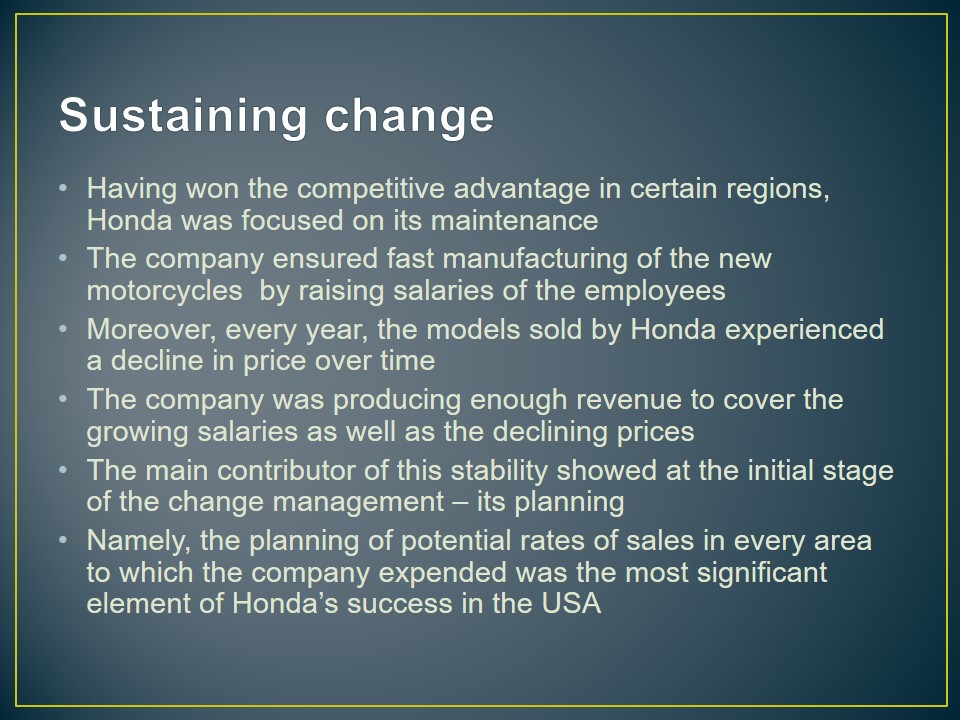
Measuring and Leading Change towards Innovation
- Having a clear plan of the perceived sales revenue for a region, the management of change would gain a clear guidance as to the future work.
- Clear goal is one of the most important aspects of change implementation.
- Besides, having a goal meant being able to measure the performance of the company based on whether or not the goal revenue was reached.
- Accordingly, the adjustments were made as soon as the perceived threats (such as stronger competition, or dropping demand) or opportunities (growing demand) appeared.
- In order to lead change towards the goal, Honda employed price changes and advertisement.
- Future opportunities: As said in the case, the American consumers were buying the Japanese light-weight motorcycles along with purchasing heavier and more powerful model of local production. Turning to innovation and adding more powerful models would be Honda’s best way to increase its market share. However, this change requires time and even more investment and planning in order to defeat strong American manufacturers.

Conclusion
- Even though the Case Study of Honda is mainly orientated at marketing strategies, it also demonstrates a company’s risky expansion to a foreign market that was based on revolutionary change that could have jeopardized the whole organization if its plan was flawed or insufficient.
- Honda’s Case Study emphasizes the importance of planning and setting clear goals for the marketers and manufacturers needed to maintain sales and defeat the competitors.
- Also, the case in an illustration of flexibility of Honda, and its determination to grow.
- Of course, the expansion required large costs in a form of investment, but the company’s focus on the long-term outcomes and not the short-term expenditures helped it break through.
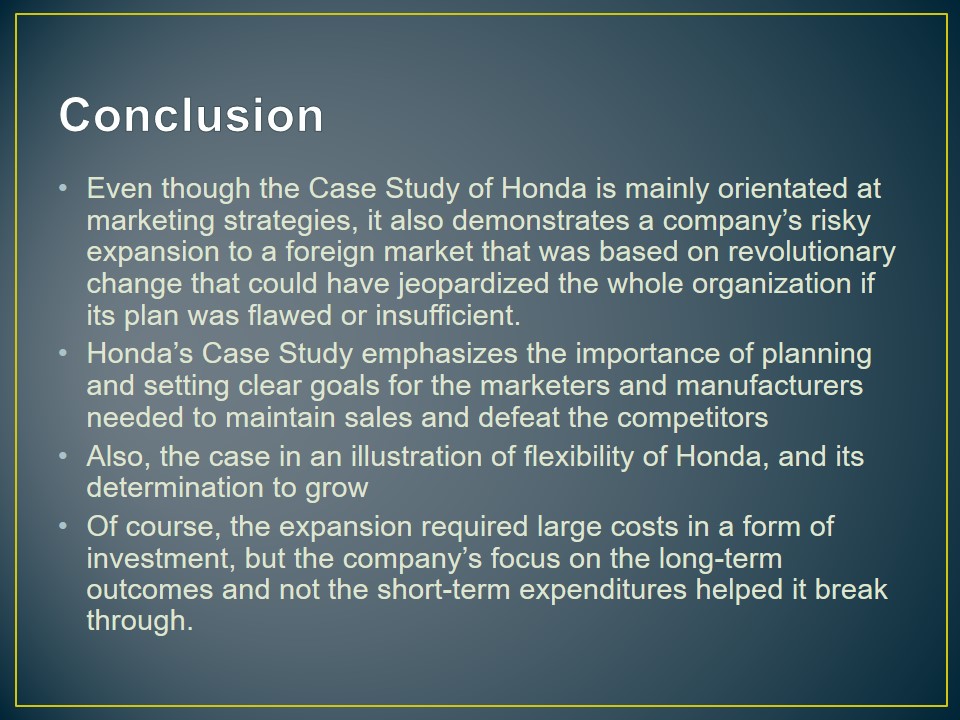
References
Jones, S. (2012). Change management: A classic theory revisited. Web
Prosci. (2016). Integrating change management and project management. Web.